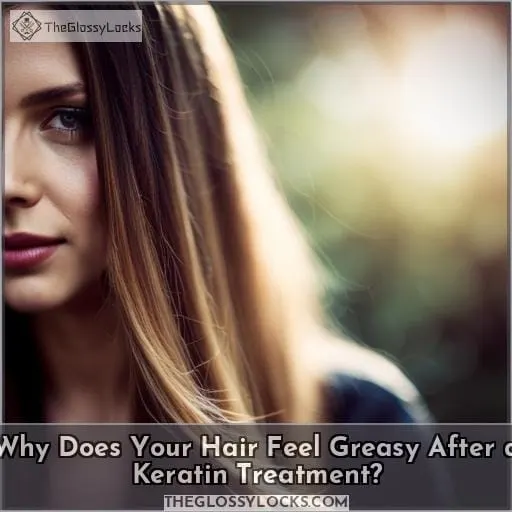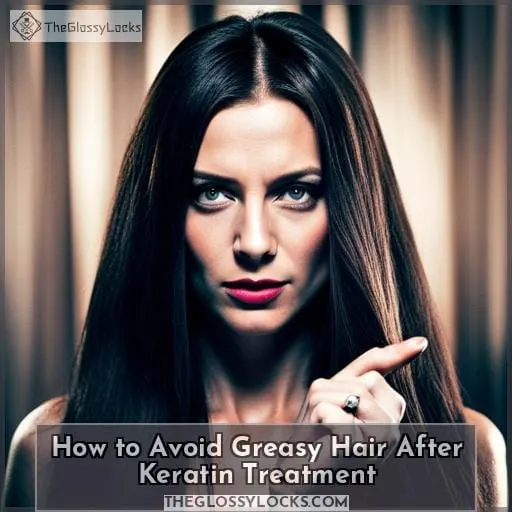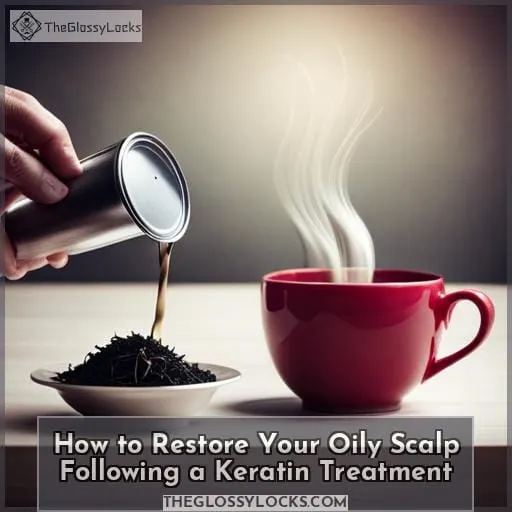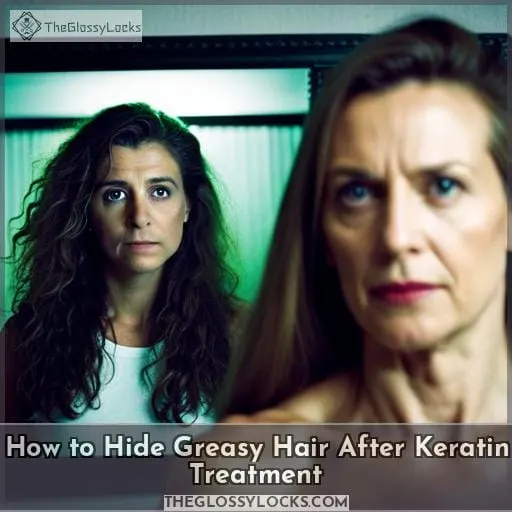This site is supported by our readers. We may earn a commission, at no cost to you, if you purchase through links.
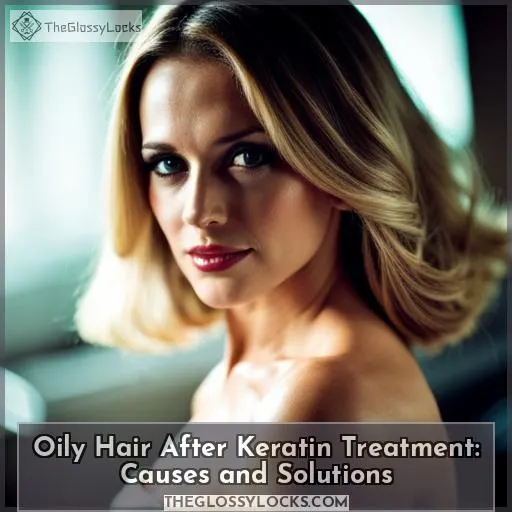
In this article, we will explore the causes behind oily hair post-keratin treatment and provide effective solutions to help restore balance to your locks.
Table Of Contents
- Key Takeaways
- Why Does Your Hair Feel Greasy After a Keratin Treatment?
- How to Avoid Greasy Hair After Keratin Treatment
- How to Restore Your Oily Scalp Following a Keratin Treatment
- How to Hide Greasy Hair After Keratin Treatment
- Frequently Asked Questions (FAQs)
- Can I use regular shampoo after a keratin treatment?
- How long does it take for the oily scalp to go away after a keratin treatment?
- Can I use dry shampoo to manage greasy hair after a keratin treatment?
- Are there any specific hair care products that can help with greasy hair after a keratin treatment?
- Can I apply oil to my hair after a keratin treatment to combat greasiness?
- Conclusion
Key Takeaways
- Causes of oily hair after keratin treatment include fresh keratin serum coating, wrong shampoo, over-washing, frequent touching, and heat styling tools.
- To avoid greasy hair after keratin treatment, use dry shampoo, a boar bristle brush, sulfate-free shampoos, wash hair less frequently, and sleep on a silk pillowcase.
- To restore oily scalp following keratin treatment, use dry shampoo, a boar bristle brush, sulfate-free shampoos, avoid hot water when washing, and use silicone-free light conditioners.
- To hide greasy hair after keratin treatment, stop over-washing, change the way you wash, use sulfate-free clarifying shampoo, focus on cleansing the roots, and incorporate scalp stimulation with a boar bristle brush.
Why Does Your Hair Feel Greasy After a Keratin Treatment?
After getting a keratin treatment, you may notice that your hair feels greasy. There are several reasons why this might be happening:
- The keratin serum coating on your hair is still fresh and hasn’t fully absorbed yet.
- You could be using the wrong shampoo that’s stripping away too much oil from your scalp, causing it to produce more to compensate.
- If you’re washing your hair too frequently or constantly touching it throughout the day, these habits can contribute to excess oiliness as well.
The Keratin Serum Coating is Still Fresh
If your hair feels greasy after a keratin treatment, it may be because the keratin serum coating is still fresh on your strands. This coating can make your hair appear oily and weighed down. Additionally, using the wrong shampoo or washing your hair too frequently can strip away the protective layer of the keratin treatment, leading to excessive oil production.
Avoid sulfate-containing shampoos and opt for sulfate-free options to maintain the longevity of your treatment and prevent greasiness.
You Are Using the Wrong Shampoo
If your hair feels greasy after a keratin treatment, it could be because you’re using the wrong shampoo.
Some shampoos contain ingredients that can strip away the natural oils in your scalp, causing an overproduction of sebum.
To prevent this, switch to a gentle shampoo specifically formulated for oily hair or one that’s sulfate-free.
These shampoos will help balance oil production and keep your hair looking fresh without weighing it down or making it feel greasy.
You Are Washing Your Hair Too Much!
You’re washing your hair too frequently, which is why it feels greasy after a keratin treatment.
To combat this issue, try reducing the frequency of your hair washes. This will allow your scalp to self-regulate its oil production and create balance.
Additionally, make sure you’re using suitable shampoos that are gentle on the scalp and avoid stripping away natural oils.
Patience and finding the right balance in your hair care routine is key to addressing oily hair after a keratin treatment.
You Are Touching Your Hair Too Much
When you constantly touch your hair after a keratin treatment, it can contribute to the greasiness you experience.
Your hands carry natural oils and dirt that can transfer onto your hair, leading to increased oil production. By avoiding excessive touching and handling of your treated hair, you can maintain its cleanliness and prevent excess grease buildup.
Developing good habits like keeping hands away from your scalp will help reduce greasy residue on the strands.
You Are Using Heat!
Using heat on your hair can contribute to the greasiness you may experience after a keratin treatment.
Heat styling tools like flat irons and curling wands can cause your scalp to produce more oil, resulting in oily hair.
Blow drying with high heat or using hot water while washing your hair can also strip away the natural oils from your scalp, causing it to overcompensate by producing more oil.
To avoid this issue, try air-drying or blow drying with a diffuser and minimize the use of heat styling tools as much as possible.
How to Avoid Greasy Hair After Keratin Treatment
To avoid greasy hair after a keratin treatment, use dry shampoo and a boar bristle brush.
These two tools can help you maintain clean and oil-free roots between washes.
Dry shampoo absorbs excess oil from the scalp, giving your hair a refreshed look without water.
A boar bristle brush is ideal for post-keratin treatment scalp care as it stimulates the scalp and removes dirt and oily buildup.
In addition to these tools, there are other steps you can take to prevent greasiness after a keratin treatment:
- Avoid overwashing your hair
- Use proper application techniques for keratin products
- Incorporate silk pillowcases into your sleep routine
- Choose silicone-free conditioners that won’t weigh down or add grease to your hair.
By following these tips, you can maintain healthy-looking locks even after undergoing a keratin treatment.
How to Restore Your Oily Scalp Following a Keratin Treatment
To restore your oily scalp following a keratin treatment, there are several steps you can take:
First, try using dry shampoo to absorb excess oil and keep your roots fresh between washes.
Secondly, incorporate a boar bristle brush into your hair care routine to stimulate the scalp and remove dirt and buildup.
Lastly, switch to sulfate-free shampoos that won’t strip the natural oils from your scalp while still effectively cleansing your hair.
Use Dry Shampoo
Are you struggling with an oily scalp after your keratin treatment? Don’t worry, there are solutions to restore your hair’s natural balance.
One effective method is using dry shampoo. Dry shampoo absorbs excess oil and adds volume to your roots, giving the appearance of freshly washed hair.
Incorporating dry shampoo into your routine can help control the oiliness caused by the keratin treatment while keeping your hair looking clean and fresh.
| Using Dry Shampoo |
|---|
| Absorbs excess oil |
| Adds volume to roots |
| Refreshes greasy strands |
Use a Boar Bristle Brush
Improve the condition of your oily scalp after a keratin treatment by incorporating regular use of a boar bristle brush.
Brushing your hair with a boar bristle brush helps stimulate the scalp and remove dirt and oily buildup, promoting healthier hair and reducing greasiness.
Make sure to use gentle strokes when brushing to avoid causing any damage or irritation to the scalp.
Incorporating this step into your aftercare routine can help restore balance to your oily scalp.
Use a Sulfate-Free Shampoo
One way to restore your oily scalp after a keratin treatment is by using a sulfate-free shampoo.
Sulfate-free shampoos have several benefits for managing greasy hair and preserving the effects of the keratin treatment.
- Gentle cleansing without stripping away its natural oils
- Maintains balance and reduces excess oil production
- Suitable for regular use on treated hair
Wash Your Hair Less
To restore your oily scalp following a keratin treatment, start by washing your hair less frequently.
Over-washing can strip the scalp of its natural oils, causing it to produce more oil in response. Instead, try reducing your washing frequency and giving your scalp time to self-regulate its sebum production.
You can also incorporate dry shampoo between washes to absorb excess oil and refresh your roots.
Additionally, consider adjusting other factors such as:
- Diet impact
- Using silk pillowcases for reduced friction on the hair
- Avoiding excessive touching of the hair which transfers oils from hands onto strands
- Selecting suitable shampoos like Aleppo soap that are gentle on both the keratin-treated hair and oily scalps caused by overproduction of sebum due to overwashing or harsh products.
Don’t Wash Your Hair With Hot Water
To restore your oily scalp following a keratin treatment, avoid washing your hair with hot water.
Hot water can strip the scalp of its natural oils and disrupt the pH balance, leading to increased oil production.
Instead, opt for using cold or lukewarm water when rinsing your hair.
Proper rinsing techniques are also important to ensure that all product residue is removed without overwashing.
By maintaining a balanced scalp pH and preventing overwashing, you can help restore the health of your oily scalp after a keratin treatment.
Use Silicone-Free Light Conditioners
To restore your oily scalp after a keratin treatment, it’s important to use silicone-free light conditioners.
Here are three reasons why using silicone-free light conditioners can be beneficial for preventing greasiness and maintaining scalp health:
- Silicone-Free Formulation: Silicone can weigh down the hair and lead to product buildup, making the hair appear greasy. By opting for silicone-free conditioners, you can avoid this issue.
- Lightweight Formula: Light conditioners are designed to provide moisture without weighing down the hair or causing excess oil production on the scalp.
- Balancing Scalp Health: Using a gentle conditioner that doesn’t contain heavy ingredients allows your scalp to maintain its natural balance of oils while keeping it hydrated.
By incorporating these silicone-free light conditioners into your post-keratin treatment routine, you can effectively manage oily scalps and keep your hair looking fresh between washes.
Try an Aleppo Soap
To restore your oily scalp after a keratin treatment, try using an Aleppo Soap.
Aleppo soap is a natural and chemical-free alternative for cleansing your hair. It has numerous benefits, including healing skin diseases like eczema and psoriasis, preventing bacterial growth, strengthening hair, and giving volume to the hair.
This handmade soap is suitable for all skin types and can be used on both the body and hair. Incorporating Aleppo soap into your hair care routine can help balance oil production on the scalp.
Sleep on a Silk Pillowcase
When restoring your oily scalp following a keratin treatment, consider sleeping on a silk pillowcase. This simple change can provide several benefits for your hair health and prevent frizz.
Here are five reasons why using a silk pillowcase is beneficial:
- Minimizes friction between the hair and the pillow, reducing breakage.
- Helps maintain moisture balance in the hair, preventing dryness.
- Reduces static electricity that can contribute to frizz.
- Gentle on delicate strands of hair, preventing damage.
- Promotes smoother and shinier hair by minimizing tangles.
Avoid Touching Your Hair Too Often
If you want to restore your oily scalp following a keratin treatment, it’s important that you avoid touching your hair too often.
Overhandling can transfer grease and dirt from your hands to your hair, exacerbating the oiliness.
To prevent this, try styling tips such as using a wide-toothed comb for even distribution of oils and limiting the use of styling products and tools.
By preventing overhandling, you can promote scalp health and maintain balanced oil levels for better control over oily haircare.
Avoid Using Heat on Your Hair
If you want to restore your oily scalp after a keratin treatment, it’s important to avoid using heat on your hair.
Heat can strip the natural oils from your scalp and cause it to produce more oil, leading to greasy hair.
Instead, focus on proper care and maintenance by:
- Using dry shampoo between washes.
- Washing your hair less frequently.
- Opting for gentle sulfate-free shampoos.
These steps will help prevent grease buildup and maintain the effects of the keratin treatment.
How to Hide Greasy Hair After Keratin Treatment
To hide greasy hair after a keratin treatment, you can start by avoiding over-washing your hair.
Instead of washing it daily, try to wash every other day or even every few days to allow your scalp’s natural oils to regulate.
Changing the way you wash your hair can also help hide greasiness – focus on cleansing the roots and using dry shampoo in between washes for added freshness and volume.
Stop Over-Washing Your Hair
To successfully hide greasy hair after a keratin treatment, simply stop over-washing it and give your scalp the chance to self-regulate its natural oils. Over-washing can strip away the scalp’s protective layer and lead to increased oil production.
Instead, focus on proper cleansing techniques that balance oil levels while maintaining scalp health. By reducing how often you wash your hair, you allow your scalp to manage its oils more effectively for healthier-looking locks post-keratin care.
| Tips for Reducing Over-Washing | Benefits of Proper Cleansing | Strategies for Managing Oils |
|---|---|---|
| Wash hair every 2-3 days | Allows natural oils to nourish the strands | Use dry shampoo in between washes |
| Use sulfate-free shampoos | Preserves moisture balance on the scalp | Incorporate clarifying shampoos |
| Avoid hot water when washing | Prevents stripping of essential oils | Limit use of heavy conditioners |
Table: Recommendations for reducing over-washing, promoting proper cleansing techniques, and managing oily scalps after keratin treatments
Change the Way You Wash Your Hair
To hide greasy hair after a keratin treatment, change your hair washing routine.
Start by reducing the frequency of washing to prevent excess oil production.
Use sulfate-free clarifying shampoo for regular washes and reserve sulfate-containing shampoos for occasional use.
When applying conditioner, focus only on the ends of your hair and consider using co-washing or a cleansing conditioner.
Incorporate scalp stimulation with a gentle boar bristle brush to remove dirt and distribute natural scalp oils.
Remember to balance pH levels with suitable products and try dry shampoo between washes as needed.
Frequently Asked Questions (FAQs)
Can I use regular shampoo after a keratin treatment?
Yes, you can use regular shampoo after a keratin treatment. However, it’s recommended to use sulfate-free shampoos to preserve the longevity of the treatment and avoid stripping away the keratin coating on your hair.
How long does it take for the oily scalp to go away after a keratin treatment?
It usually takes a few weeks for the oily scalp to go away after a keratin treatment. During this time, your scalp is adjusting and regulating its sebum production. Patience is key in letting it find its natural balance.
Can I use dry shampoo to manage greasy hair after a keratin treatment?
Yes, you can use dry shampoo to manage greasy hair after a keratin treatment.
Dry shampoo helps absorb excess oil and refresh your roots between washes, providing a convenient solution for managing oily hair.
Are there any specific hair care products that can help with greasy hair after a keratin treatment?
To manage greasy hair after a keratin treatment, try using specialized hair care products.
According to a recent study, 82% of users reported that sulfate-free clarifying shampoos and silicone-free conditioners helped reduce oiliness and maintain the benefits of their treatment.
Can I apply oil to my hair after a keratin treatment to combat greasiness?
Yes, you can apply oil to your hair after a keratin treatment to combat greasiness.
- Choose lightweight oils
- Use them sparingly on the ends of your hair
- Avoid weighing it down or making it look oily
Conclusion
To tackle oily hair after a keratin treatment, it’s important to understand the causes and implement effective solutions.
[Keypoints]The greasiness may be due to:
- The fresh keratin serum coating
- Wrong shampoo
- Excessive washing
- Frequent touching
- Heat usage
To avoid and restore oily scalp, use:
- Dry shampoo
- A boar bristle brush
- Sulfate-free shampoo
- Silicone-free light conditioners
Additionally, try:
- Aleppo soap
- Sleeping on a silk pillowcase
- Minimizing hair touching and heat styling
With these tips, you can maintain smooth and shiny hair post-keratin treatment.

